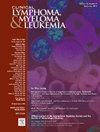Prognostic Value of Dynamic Measurable Residual Disease Monitoring by Multiflowcytometry in Elderly Patients With Nonintensively Treated Acute Myeloid Leukemia
IF 2.7
4区 医学
Q2 HEMATOLOGY
引用次数: 0
Abstract
Purpose
The clinical prognostic value of monitoring minimal residual disease (MRD) in acute myeloid leukemia (AML) patients undergoing nonintensive treatment remains insufficiently established. The aim of this work was to examine MRD status at various time points, highlighting the potential for pre-emptive therapy to improve patient outcomes.
Methods
Inpatient data from 2017 to 2024 were used in this retrospective study. Bone marrow samples were analyzed for MRD using multiparametric flow cytometry at the end of cycles 1, 2, 4, and 7, before the next therapy course. Kaplan-Meier method and Cox regression were used to assess factors affecting overall survival (OS) and disease-free survival (DFS), and logistic regression evaluated the interaction between MRD and baseline features.
Results
A total of 108 patients were enrolled for MRD evaluation. MRD1, MRD2, MRD4, and MRD7 was significantly associated with both OS and DFS. Early MRD negativity leads to longer survival time, and the later MRD turns negative, the higher the risk of relapse, and ELN 2017 high risk and myeloid gene mutation are adverse factors affecting time to MRD negative status.
Conclusion
Dynamic MRD monitoring has predictive value for nonintensive treatment in AML patients. Proper use of MRD and baseline features allows treatment adjustments based on an accurate estimation of relapse risk.
多流式细胞术动态可测量残余病变监测对老年急性髓系白血病患者预后的价值。
目的:在急性髓系白血病(AML)患者接受非强化治疗时监测微小残留病(MRD)的临床预后价值尚不充分确定。这项工作的目的是检查不同时间点的MRD状态,强调先发制人治疗改善患者预后的潜力。方法:采用2017 - 2024年住院患者资料进行回顾性研究。在第1、2、4和7周期结束时,在下一个疗程开始前,骨髓样本使用多参数流式细胞术进行MRD分析。Kaplan-Meier法和Cox回归评估影响总生存期(OS)和无病生存期(DFS)的因素,logistic回归评估MRD与基线特征之间的相互作用。结果:共有108例患者入组进行MRD评估。MRD1、MRD2、MRD4和MRD7与OS和DFS均显著相关。早期MRD阴性导致生存时间延长,而越晚MRD转为阴性则复发风险越高,而ELN 2017高风险和髓系基因突变是影响MRD阴性时间的不利因素。结论:动态MRD监测对AML患者非强化治疗具有预测价值。正确使用MRD和基线特征可以在准确估计复发风险的基础上调整治疗。
本文章由计算机程序翻译,如有差异,请以英文原文为准。
求助全文
约1分钟内获得全文
求助全文
来源期刊

Clinical Lymphoma, Myeloma & Leukemia
ONCOLOGY-HEMATOLOGY
CiteScore
2.70
自引率
3.70%
发文量
1606
审稿时长
26 days
期刊介绍:
Clinical Lymphoma, Myeloma & Leukemia is a peer-reviewed monthly journal that publishes original articles describing various aspects of clinical and translational research of lymphoma, myeloma and leukemia. Clinical Lymphoma, Myeloma & Leukemia is devoted to articles on detection, diagnosis, prevention, and treatment of lymphoma, myeloma, leukemia and related disorders including macroglobulinemia, amyloidosis, and plasma-cell dyscrasias. The main emphasis is on recent scientific developments in all areas related to lymphoma, myeloma and leukemia. Specific areas of interest include clinical research and mechanistic approaches; drug sensitivity and resistance; gene and antisense therapy; pathology, markers, and prognostic indicators; chemoprevention strategies; multimodality therapy; and integration of various approaches.
 求助内容:
求助内容: 应助结果提醒方式:
应助结果提醒方式:


